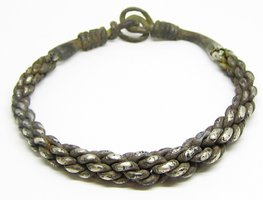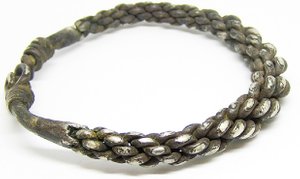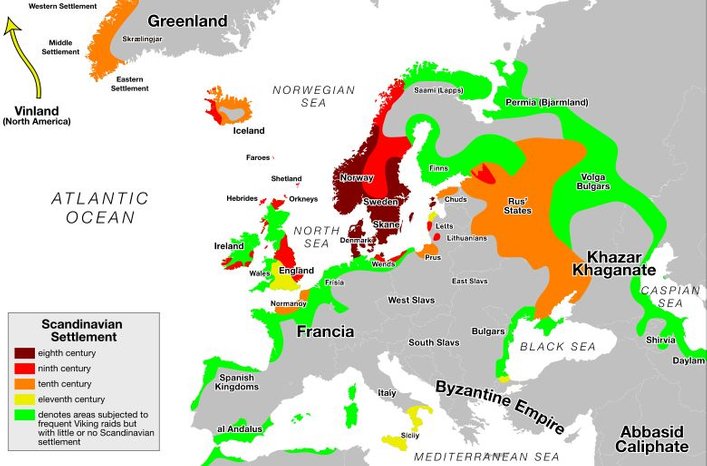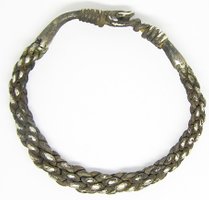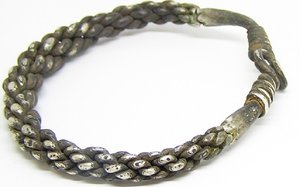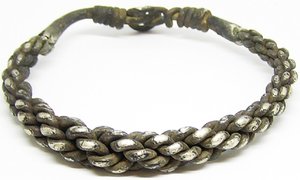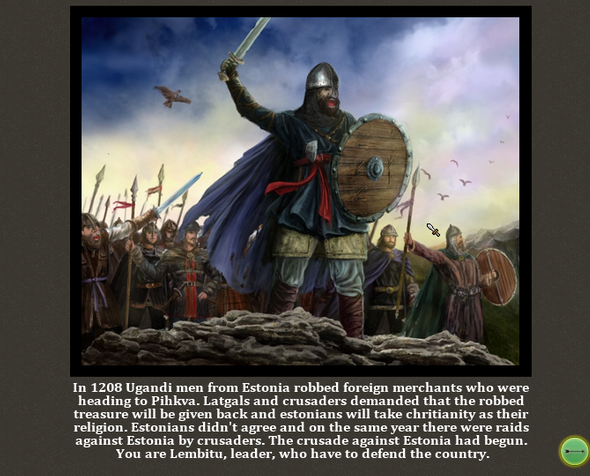Viking braided silver bracelet
This is a superb ancient Viking braided silver bracelet / Oath-ring, dating to the 9th - 10th century A.D. It is formed from rods of silver, twisted about each other in a ropework formation, the terminals welded, forming a double spiral decorative element. This type of double spiral can be found on other Viking silver bracelets from Gotland in Sweden see here. This example recovered during dredging work is intact, though parts of the original weld has failed due to the conditions of sediment and machinery, this has been repaired but sadly it is no longer suitable to be worn. This bracelet is a very rare museum grade example, classic Viking workmanship and presence. Such an item would have been a prize piece of jewellery, worn as an 'Oath-Ring', given by a Jarl to brave and worthy subject. The silver likely taken at some stage as booty in raids, used as form of currency in a barter system of exchange. The weight of this bracelet alone would have been the monetary equivalent of at least 42 silver pennies, when 1 penny would have bought you 15 chickens! A wonderful piece of iconic Viking jewellery for the serious collector.
So far for the salesman advertisement ! So.. it got in hands of the serious collector ..
A bracelet / arm ring of this braided type I think was a one off chance to aquire for my collection.
Altough somewhat 'weathered' by the conditions of sedementary and machinary, a highly collectable piece of distinct Viking Age silver art.
This bracelet was discovered during dredging on a construction site near the Jarise järv lake in Estonia.
It measures in size: 74.41mm x 78.01mm x 9.70mm (internal 65.90mm x 58.07mm) and its weight is 53.2 grams.
Estonia was at that time "a house beside the road" or a staging post. The trade-routes between Northern Europe, through Russia East to Persia, passed through here. see Vikings in Estonia and Estonian Vikings
The island of Jarise järv lake as can be seen on the map below is coloured dark red. The dark red areas indicate original Viking settlements.
Estland (Eistland or Esthland) is the historical Germanic language name that refers to the country at the eastern shores of the Baltic Sea, and is the origin of the modern national name for Estonia. The largest island of Estonia is called Ösel in Swedish and its inhabitants used to be called Oeselians
The Oeselians were known in the Old Norse Icelandic Sagas and in Heimskringla as Víkingr frá Esthland (English: vikings from Estonia).
The history of the vikings of Estonia is a remarkable one if one is till to consider (I am not) to pinpoint 'The Viking Age' between 793 A.D. and 1066 A.D. - as that addresses a British actuality, certainly not the actuality all over the Viking world.
Around 850 A.D. Estonia was on the southeastern trading route of the Vikings to the Black Sea and Turkey onwards. In the following centuries Slavic tribes from Russia failed to submit the citizenry and missionaires from Denmark, Sweden and Germany failed either attempting to christianize the people. In 1093 A.D. the pope even sent crusaders to the area. Around 1187 A.D. (!) vikings from Estonia plundered Swedish towns, but finally in 1227 A.D. German knights succeeded, after more than 25 years of resistance of the Estsled by Lembitu, to get control on large parts of the coastal areas.
See also the Lembitu hill fort and the article The first Vikings
Well. I could have been with these stones until after dark, but as my wife wanted to travel on.. well.. I see you again, some day, hogback stones from Gosforth. And if you happen to be there one day, do not forget that monument on the outside...
Further on with the Cumbrian hogbacktour !
In - yes, luckily again in - St. Peter's church in Heysham, there is a truly beautiful hogback stone. The guide told us, it had been studyied by Thor Ewing, a writer, in 2000. in 'Understanding the Heysham hogback' A tenth century sculpted stone monument and its context (link), Thor Ewing tells in detail what he dicovered on the both sides of this hogback stone.
Just being brought in the church as late as the 1970's accompanied with some protest here and there among the church visitors, considered as being a token of old paganism, it had been remarkably nice preserved, and a lot of detail can be seen, still. Truly worthwile a visit.
I had a small debate with the guide in the church if the - zoomorphic, in my opinion - faces on the sides were lions (or hippo's). The guide doubted if the vikings could have known about lions. Well I guess so, concerning the runes on the Ancient Greek lion statue at the Arsenal, Venice. For example. Vikings did travel south..
But when he told me he was doubting the vikings 'discovered' (as the native inhabitants were of course, in the first place) America before Columbus, I decided to rest my case..
One has to know when to start and to end a conversation ..
Just discovered the book in a bookstore written by Geoff Holder - The guide to the mysterious Lake District, I knew there had to be another hogback stone in Lowther, St. Micheal's Church. With a promising image described in the text of 'a naval and a land-based force of shield-bearing vikings above a fish and what might be a coiled sea serpent. On the reverse is a row of female figures with snakes, possibly a representation of the hideous hag Hel'. Wow. If that did not sound as a true pagan promised land ..
Not complaing too much after all we have seen, this visit was the dissapointing one of them all. But if you wife states 'I am happy to have seen them' and I am answering 'Measuring is knowing' and the even more obligate verb 'handling 'if we did not see it at all, we wouldn't have known anything at all of how they were looking' the glass was again half full, at the last day of our journey..
The hogback stone appeared to be just being tolerated within the entrance segment part of the church. As something you never use anymore but you do not throw away - entirely. That sort of feeling emerged when seeing this hogback asylum seekers.. Bed, bath and bread, ás we say in Dutch, but no luxury at all and standing on some outcuts of wood, you would balance the table with at home..
Come on, St. Micheal's Church.. care a bit more of your 'children' !
This hogback stone was moved in the church in 1907. Hogback stones layed partially buried in the churchyard before it was dug up and moved into the church.
The promising depiction of a longship - as certainly can be seen after some studying - see http://vikingminds.co.uk/pages/longship
we have missed !
The stone itself is (157 x 50 x 30 cm) and very worn.
The hogback stones in Cumbria - very diverse in quality, but everyone worth a visit ! Especially on a gloomy day in late October ...
The churches to visit - see photos of resp. St. Andrew's church in Penrith, St. Mary's church in Gosforth, St. Peter's church in Heysham and St. Micheal's church in Lowther.
Did I miss out on another one in Cumbria ? Let me know !
In a next blog I will take you to four - still remaining utterly mysterious- statues 'guarding' the graveyard of St. Andrew's church in Dacre..
For the last blog of October 9th see this link.
References: (as always, links to where the books can be ordered are attached).
Edwards, B.J.N. Vikings in North West England - The artifacts (1998);
Emery, Gordon, CURIOUS CUMBRIA, The Lake District & Beyond: A celebration of Cumbria (2023)
Ewing, T. 'Understanding the Heysham hogback' A tenth century sculpted stone monument and its context ;
Hall, R. Viking Age archaeology in Britain and Ireland (first printed 1990, reprinted with amendments in 1995);
Holder, G. The guide to the mysterious Lake District (2009)
possibly also (as there within the part of Cumbria dealing with Carlisle, the Eden Valley, Barrow-in-Furness, Whitehaven and the west coast is being dealed with)
Holder, G. Paranormal Cumbria (2010)
http://vikingminds.co.uk/pages/longship
